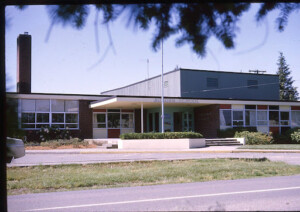Auburn Elementary School
Auburn Elementary School started out as Union Sunday School in 1902. The building consisted of only one room.It was located on Auburn Road and was surrounded by farmland. The school was established and conducted by Mr. and Mrs. Albert Williams and their daughter Mable Williams. Reverend Poling Sr. of the Salem Presbyterian Church was the supervising minister for the Sunday School. School District 118, which administered Auburn Elementary was established June 24, 1891 by a community petition.
The area and the school was named by Mr. Joe Albert who owned a large amount of land in the area. He was very pleased by the new school and its name and so donated a favorable amount toward a new Sunday school piano.
In 1903 Auburn recorded its first salaried teacher, Marion Hetrick. She earned $35.00 a month for seven months of the year. In 1904 Evelyn Nash was hired at a monthly salary of $45.00. By 1907, her salary had increased to $60.00. The first directors of the school were Martin Hohl, A. Williams, Professor J. J, Krapps, W. Mathey, C. E. Bradley and A. Perlich.
James McKenney was a student of Auburn in the early 1920’s. He remembers that one teacher taught 65 students and eight grades. Teachers were also responsible for all the janitorial work for a mere $65.00 a month. He specifically remembered his seventh grade teacher, Nellie Hammer. Miss Hammer was not much older than some of her students. To keep the children in line, she would hit them over the head with wooden ball attached to the end of the sash on her dress.
Significant changes happened in 1923 when the original one-room school building was sold and moved to “Misery Alley” to become a residence. Misery Alley is now Monroe Avenue, and is located directly South of Auburn School. Mr. Krapps and Mr. Brownlee worked on the conversion of the building. This home is still standing and located on Monroe Avenue.
A new two room school house was then erected in the original location. The lower four grades met in one of the rooms and the upper two grades met in the other. The cost was $10,500. In 1937 one more room was added to the growing school for $9,240. Most of the cost was offset by a donation of labor and materials from the Public Works Administration and the Works Progress Administration. Only $1,200 was needed from the school district. In 1938 yet another room was added at a cost of $4,762. This building was later torn down to make way for the current building. The salvaged materials were used to build a house that currently sits on Auburn Road.
As time moved on, Auburn School was a pioneer in the move to consolidate schools within the Salem area. In 1946 the board met to discuss the matter. Members of the board included John Olson, E. C. Sunderlin, Lloyd Lee, Agnes Booth (representative for District 118), Mrs. Faye Wright and Mr. Bennett (representative for District 24). As a result of the meeting, District 118 was eliminated and became a part of District 24.
In 1955 the current building was erected for a cost of $248,631.95. It sits in the same location as the original one-room school house did at 4612 Auburn Road. Dr. Walter Snyder was the Superintendent of School District 24CJ at the time. The original building housed eight classrooms, a library, an office, a multi-purpose room, a health center and a special education room. The building still has the original brick veneer but now has a total of 20 classrooms and a gymnasium.
James McKenney’s nephew, Chris Feskens attended the school in the 1950’s. In an interview for the Statesman Journal he told about his grandmother who cooked lunch for the entire school. She would wheel a cart into each classroom at lunch time filled with hot food. Both James McKenney and Chris Feskens remember Auburn as a close-knit community and the school as a meeting place for many social events.
Auburn was nicknamed the Auburn Astros and their mascot is an astronaut The school’s colors are blue and white. Auburn currently serves 585 children who attend kindergarten through fifth grade. The school is also bilingual and has a staff of 55. This recent information was obtained in a telephone interview with Auburn staff.
All of the details of the history of Auburn School are provided by a write up from the school itself. The author and date are unknown.
Compiled and written by Yvonne Litke
This article originally appeared on the original Salem Online History site and has not been updated since 2006.








Leave A Comment